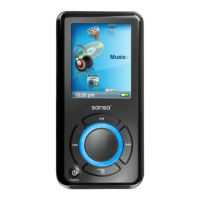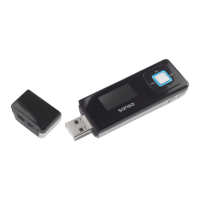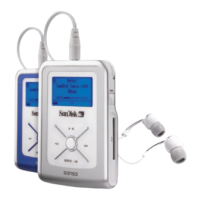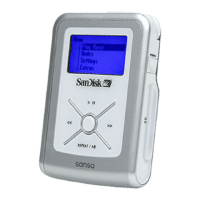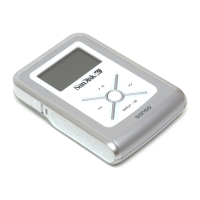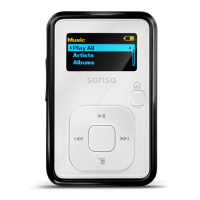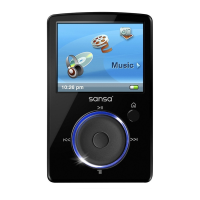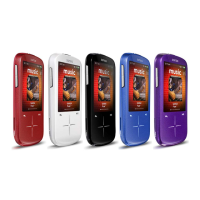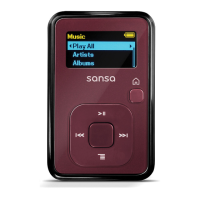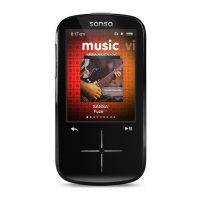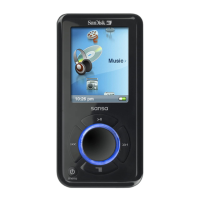
Do you have a question about the SanDisk Sansa e200 Series and is the answer not in the manual?
| Storage Capacity | 2GB, 4GB, 6GB, 8GB |
|---|---|
| Battery Life (Audio) | Up to 20 hours |
| Audio Formats Supported | MP3, WMA, WAV, Audible |
| Video Formats Supported | MPEG-4, WMV |
| FM Radio | Yes |
| Voice Recording | Yes |
| Microphone | Built-in |
| USB Interface | USB 2.0 |
| Expandable Storage | microSD card slot |
An overview of Rockbox as an open-source firmware replacement for digital audio players.
Information on accessing further documentation, forums, mailing lists, and IRC channels for support.
Explains conventions for naming and icons used in the manual for clarity.
Key information to know before beginning the installation process, including hardware versions and USB connection.
Details the process of installing the Rockbox bootloader, including automated and manual methods.
Guide to using the Rockbox Utility for an automated installation of the firmware and components.
Step-by-step instructions for manually installing Rockbox firmware and bootloader.
Steps to complete the installation process and ensure Rockbox loads correctly upon reboot.
Solutions for common problems encountered during bootloader installation and firmware issues.
Explains the physical controls of the player and their functions within Rockbox.
How to personalize the Rockbox User Interface using themes, fonts, and colors.
Instructions on how to charge the player over USB while it is running Rockbox.
How to navigate through files and directories on the player, including browsing and context menus.
How to browse music using categories like artist, album, and genre, and database initialization.
Information displayed on the screen during audio playback, including controls and customization.
Creating, managing, and modifying playlists in Rockbox, including terminology and saving.
Shortcut keys for quick access to functions in File Browser and WPS screens.
Overview of the main menu as the central access point for Rockbox functions and navigation.
How to access and adjust various player parameters via the Settings menu and its submenus.
Options to customize sound properties like volume, bass, treble, and equalizer.
Settings to configure shuffle, repeat, crossfade, and other playback behaviors.
Options for customizing Rockbox's appearance, file views, and system behavior.
How to set up the Quick Screen for rapid access to favorite settings and options.
How to adjust the music volume using a decibel scale from -74 dB to +6 dB.
Settings to emphasize or suppress lower bass frequencies in the sound from -24 dB to 24 dB.
Using the parametric equalizer to adjust frequency, gain, and width of EQ bands for audio tuning.
Configuring shuffle playback and repeat options for directories or playlists (Off, All, One, Shuffle, A-B).
Adjusting settings for smooth transitions between tracks, including fade in/out delays and durations.
How Rockbox handles reaching the end of a directory, with options to continue or stop playback.
Options for configuring how playlists are managed, including recursive directory insertion and warnings.
Options controlling how files and directories are displayed, sorted, and filtered in the File Browser.
Adjusting player display settings like backlight behavior, LCD modes, and screen scrolling.
Settings related to the device's system, disk caching, limits, and startup/shutdown behavior.
How Rockbox automatically stores and recalls playback positions for tracks, including on automatic track changes.
How to browse, select, and apply installed or downloaded themes to customize the player's appearance.
Information on browsing and activating installed fonts for use with themes.
How to customize the appearance of the WPS using theme files and .wps files.
Options to configure the on-screen status bar display and scrollbar appearance.
Choosing the file format for saving recordings (PCM Wave, AIFF, WavPack, MP3).
Setting the sample rate for recordings (e.g., 24 kHz, 22.05 kHz, 16 kHz).
Configuring how to split long recordings into manageable pieces based on time or size.
Using the trigger feature to automatically start recordings based on sound levels and duration.
How to set the device's current time and date.
Option to select between 12-hour and 24-hour clock formats for display.
Introduction to the various games available as Rockbox plugins, including 2048 and Blackjack.
Description of the demo applications included with Rockbox, such as Bounce and Cube.
Information on plugins used to view specific file types like images, text, and Chip-8 games.
Overview of utility applications such as Alarm Clock, Battery Benchmark, and Calculator.
How to customize the main menu, load fonts, and change filetype colors for UI elements.
Details on theme configuration, including general info, creating themes, and viewport setup.
How to use configuration files (.cfg) to store, load, and manage multiple settings profiles.
Tips and settings to maximize battery life, covering display, audio processing, and CPU usage optimization.
A table listing supported file types, their extensions, and actions when selected in the browser.
Lists supported audio codecs, detailing both lossy and lossless formats.
Overview of metadata tag types supported by Rockbox for audio files, including ID3, APE, and Vorbis.
Details on the limitations of embedded and stored album art support, including supported image formats.
Explains where to place image files for them to be recognized by Rockbox for display.
Tags used to control the visibility and appearance of the status bar elements.
Tags for displaying artist, title, album, track number, and other metadata from audio files.
Tags used to define display areas and conditional viewports within custom themes.
Guidelines for reporting bugs, including essential information like player model and steps to reproduce.
How to suggest new features and where to find existing ideas for Rockbox development.
The full text of the GNU Free Documentation License, Version 1.2, governing document usage and distribution.
